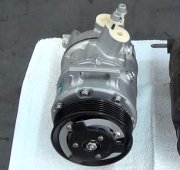Forget all the electrical tests. By your own observations, everything is working. It sounds like the system is just really low on charge.
Before we go any further, you are fortunate that Chrysler is the only manufacturer that used a sight glass that was accurate, to tell when the system is fully-charged. Adding too much refrigerant is potentially more harmful that having too little, so when full is good, more is not better. Loosen the jack and handle under the hood, then you will see the round receiver-drier on the inner fender. There is a 1/4"-diameter round sight glass right in the middle of that. Fill the system just until you no longer see vapor bubbles flowing through there.
When the compressor cycles off, the high and low sides will want to equalize. That is where you are seeing the 45 pounds come from. When the compressor turns on, it is pumping the low side down too low. You do not want to see it go much below 40 psi. There is a low-pressure cut-out switch that turns the compressor relay off when low-side pressure gets too low. Refrigerant has a nice coincidence that its pressure is nearly identical to its temperature, (when the system is at rest). The low side is regulated to not go below about 40 psi because that means the evaporator in the dash is at 40 degrees. The goal of any AC system is to lower the air temperature by only 20 degrees. The comfort comes from condensing out the humidity. That moisture collects on the evaporator just like it does on the side of a carton of cold milk. If the evaporator were to get down to 32 degrees or lower, that water would freeze into a block of ice that would block air flow.
That is the regulating part of the story. The low-pressure cut-out switch part of the story has to do with a leak in the system. If the refrigerant is lost and the compressor was able to run, it could draw in outside air and the humidity in it. Moisture and refrigerant combine to form an acid that will attack metal parts in the system. Also, if a drop of moisture was circulating in the system, it would freeze at the expansion valve and block the flow of the refrigerant. The typical symptom is it cools fine for a few minutes, then you get only warm air for about an hour, until that ice melts.
Any time the system is that low, we repair the leak, then pump it into a vacuum for at least half an hour. In a vacuum, water boils at 77 degrees. That turns it into a vapor that is easy to pump out. That vacuum also aids in starting to put some refrigerant into the system.
If you started with 0 psi in the system, the compressor will not be running, and it will be hard to get the refrigerant to go in. To be that low, there is likely a leak that needs to be located and repaired first, then you need to pump it into a vacuum. If there was some pressure yet, you need to get enough refrigerant in to get the low-pressure cut-off switch turned on. If that is the only issue, moisture is not a concern. To make the compressor stay on, unplug the low-pressure cut-off switch, then jump the two terminals in the plug. I use a stretched-out cotter pin or paper clip. The compressor will draw the low side down well below the pressure in the little can. You will feel the can get real cold when the refrigerant is going in.
Be sure to always keep the can upright. That makes the refrigerant boil and go in as a harmless vapor. If you hold the can upside down, liquid will go in, and with the charging port so close to the compressor, that liquid can lock up the compressor and damage it. That is also what an over-charged system can do.
Watch the sight glass. Foam is a sign the system is real low on charge. You will see fewer and fewer bubbles as the system becomes fully-charged. If it takes more than ten to fifteen minutes and the can still feels heavy, try setting it in a pot of hot water. That can make everything go in within less than a minute. When you approach a full charge, you will see the gauge on the charging hose stay above 35 to 40 pounds.
Be aware too that those charging ports always leak. The purpose of the valves in them is to hold the refrigerant in to give you time to screw on the caps. Those caps have rubber seals in them, and that is what does the sealing. Do not leave a cap off when you are done.
I should mention too that refrigerant is extremely dangerous to work with. It can cause frost bite and blindness. Professionals wear gloves, safety glasses, and a face shield.
Saturday, August 12th, 2017 AT 9:38 PM


